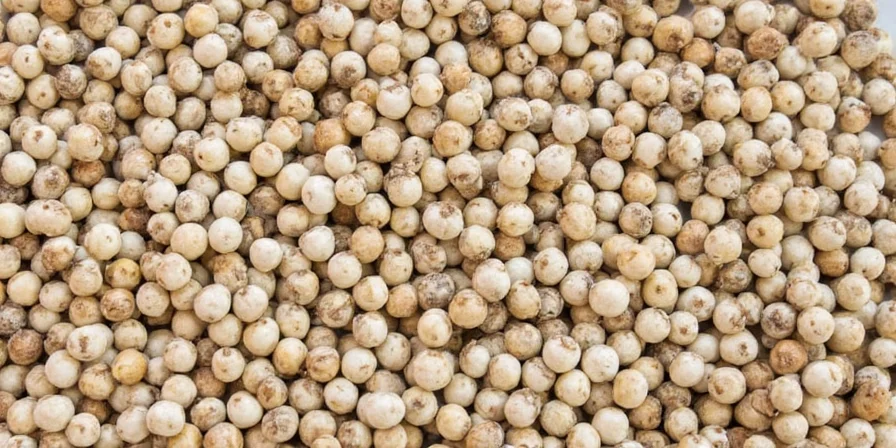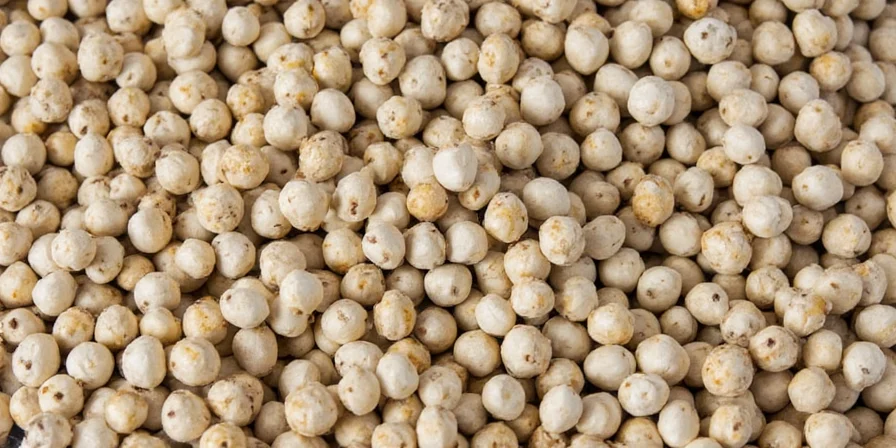White peppercorns vs black: Here's exactly when to use each. White pepper isn't just black pepper's pale cousin—it solves specific cooking problems black pepper can't. Discover why professional chefs reach for white pepper in creamy sauces, Asian broths, and delicate dishes where black pepper would ruin both appearance and flavor balance.
You'll learn the 3 key differences that matter in your kitchen, how to store white pepper properly (most people do it wrong), and why Vietnamese white pepper dominates global markets. No culinary degree needed—just practical, immediately usable techniques.
Table of Contents
- What White Peppercorns Really Are (Simple Explanation)
- White Pepper vs Black Pepper: The 3 Critical Differences
- When to Use White Pepper (5 Specific Situations)
- How to Buy Good White Peppercorns
- Storage Mistakes That Kill Flavor
- Easy Recipes That Need White Pepper
- Why Asian Cuisines Prefer White Pepper
- Common Questions Answered
What White Peppercorns Really Are (Simple Explanation)
White peppercorns come from the same plant as black pepper (Piper nigrum), but they're fully ripe berries with the outer layer removed through soaking. This process creates a milder, earthier spice perfect for dishes where black pepper's sharp bite would overwhelm.
- Black peppercorns: Made from unripe green berries, sun-dried with outer layer intact
- White peppercorns: Made from ripe red berries, soaked to remove outer skin
This difference explains why white pepper has less heat and works better in light-colored dishes—no black specks, smoother flavor.

Where Most White Pepper Comes From
Vietnam produces 60% of the world's white pepper, mainly from Phu Quoc island. Their modern soaking methods create cleaner-tasting pepper than older rice paddy techniques. When buying, look for "Vietnamese white pepper"—it's the professional standard for good reason.
White Pepper vs Black Pepper: The 3 Critical Differences
Don't just substitute blindly—choose based on these key differences:
| Factor | White Pepper | Black Pepper |
|---|---|---|
| Best for | Cream sauces, light soups, mashed potatoes | Steaks, dark sauces, roasted meats |
| Heat level | Milder, more earthy | Sharper, citrusy notes |
| When to add | Early in cooking (holds up to heat) | Late in cooking (loses flavor with heat) |

When to Use White Pepper (5 Specific Situations)
Reach for white pepper in these common cooking scenarios:
- Cream sauces: Béchamel, Alfredo, or cheese sauces—black pepper leaves ugly specks
- Chicken soup: Keeps broth clear while adding subtle warmth
- Asian cooking: Essential for authentic Chinese and Vietnamese dishes like wonton soup
- Light-colored dishes: Mashed potatoes, white chili, fish sauces
- Long cooking times: Braises and stews where black pepper's flavor fades

How to Buy Good White Peppercorns
Most supermarket white pepper contains stale or moldy product. Use these simple checks:
| What to Check | Good Quality | Poor Quality |
|---|---|---|
| Color | Uniform light beige | Gray or yellow spots |
| Smell | Clean, earthy scent | Musty or sour odor |
| Texture | Firm, whole berries | Crumbly or broken |
| Source | Vietnam (Phu Quoc) | Unknown origin |

Storage Mistakes That Kill Flavor
White pepper loses flavor twice as fast as black pepper. Avoid these common errors:
- Mistake: Storing in clear containers Solution: Use dark glass or opaque containers (light degrades flavor 40% faster)
- Mistake: Keeping in a spice rack near stove Solution: Store below 70°F away from heat and moisture
- Mistake: Buying pre-ground white pepper Solution: Always buy whole peppercorns and grind fresh
Pro tip: Vacuum-seal unused pepper and freeze—it stays fresh for up to 2 years.
Easy Recipes That Need White Pepper
These simple dishes work best with white pepper:
- Creamy Mushroom Soup
Add ½ tsp freshly ground white pepper at the end for subtle warmth without black specks. - Classic Mashed Potatoes
Mix ¼ tsp white pepper into hot potatoes for even flavor (black pepper would create dark spots). - Vietnamese Pho Broth
Toast 1 tsp whole white peppercorns before adding to broth for authentic flavor. - White Chicken Chili
White pepper blends seamlessly where black would stand out unpleasantly. - Homemade Mayonnaise
Add just a pinch of white pepper for depth without visual distraction.

Why Asian Cuisines Prefer White Pepper
It's not just about appearance. In Chinese and Vietnamese cooking, white pepper's earthy warmth balances cooling ingredients like tofu and seafood better than black pepper. The fermentation process matches traditional cooking methods, creating seamless flavor in dishes like:
- Wonton soup
- Steamed fish with ginger
- Pho broth
- Dumpling dipping sauces
Black pepper would clash with delicate ginger notes, while white pepper enhances them.
Common Questions Answered
Can I substitute white pepper for black pepper?
Yes, but adjust amounts. Use 25% more white pepper to match black pepper's heat. In creamy dishes, use equal amounts since white pepper blends better visually.
Why does my white pepper taste musty?
This means it's gone bad. Fresh white pepper should smell earthy and clean. Mustiness indicates mold—discard immediately. Store in airtight container away from light and moisture.
Is white pepper healthier than black pepper?
They have different benefits. White pepper is gentler on digestion, while black pepper has more piperine (which boosts nutrient absorption). For sensitive stomachs, white pepper may be better.
Should I grind white pepper differently?
Yes. White peppercorns are softer than black, so use a coarser grind setting. Fine grinding makes white pepper bitter. Always grind just before using for best flavor.
White peppercorns solve specific cooking problems black pepper can't. Use them when appearance matters, in long-cooked dishes, or for authentic Asian flavors. Keep them stored properly, and you'll notice an immediate improvement in your cream sauces, soups, and delicate dishes.











 浙公网安备
33010002000092号
浙公网安备
33010002000092号 浙B2-20120091-4
浙B2-20120091-4